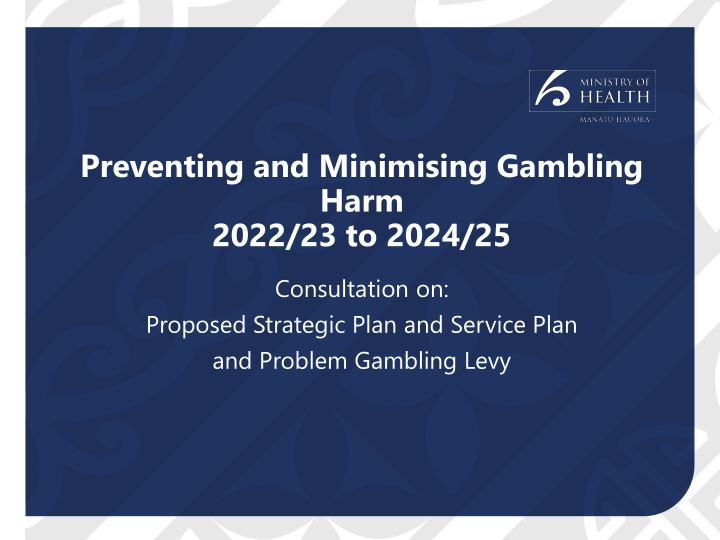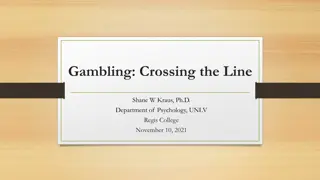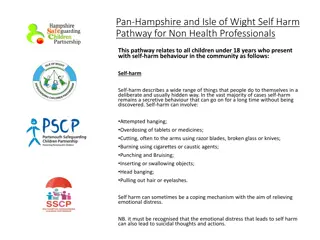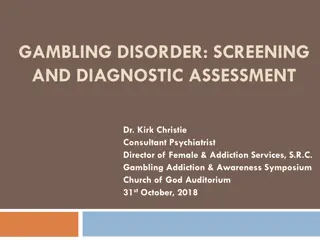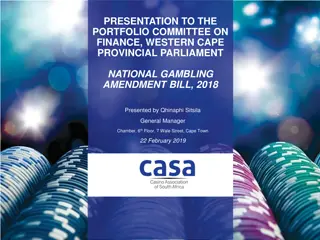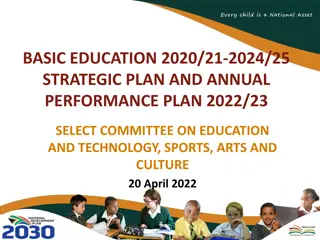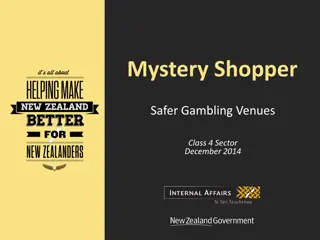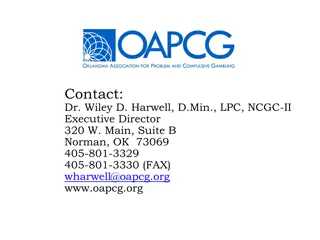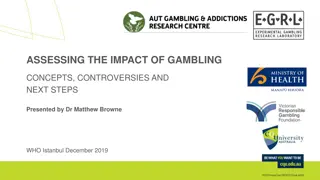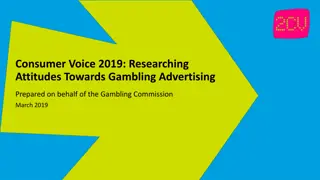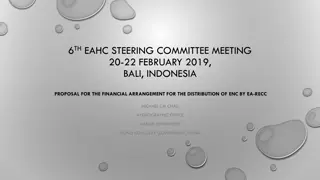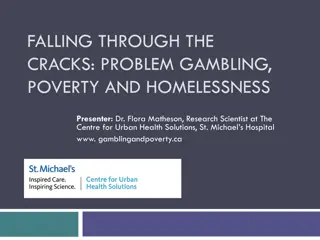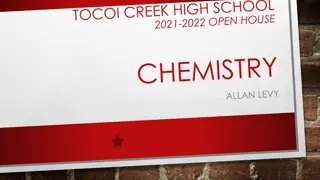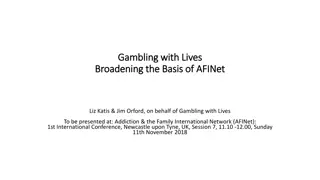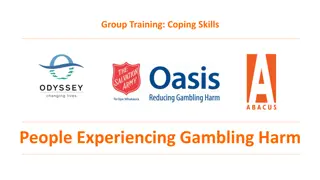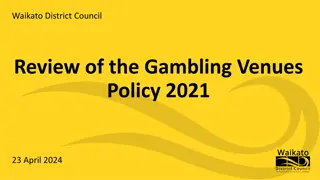Consultation on Preventing and Minimising Gambling Harm 2022-2025 Strategic Plan and Levy Proposal
The consultation focuses on the proposed strategic plan and service plan to prevent and minimize gambling harm from 2022 to 2025. It covers the context of gambling harm, the Gambling Act requirements, problem gambling levy, and the assessment of gambling harm needs. Key points include the definition of gambling harm, strategies required by the Gambling Act 2003, assessment of gambling harm in 2021, and the impact on young people. The need for integrated services and research to address the growing challenges of gambling harm is emphasized.
Uploaded on Sep 29, 2024 | 2 Views
Download Presentation

Please find below an Image/Link to download the presentation.
The content on the website is provided AS IS for your information and personal use only. It may not be sold, licensed, or shared on other websites without obtaining consent from the author.If you encounter any issues during the download, it is possible that the publisher has removed the file from their server.
You are allowed to download the files provided on this website for personal or commercial use, subject to the condition that they are used lawfully. All files are the property of their respective owners.
The content on the website is provided AS IS for your information and personal use only. It may not be sold, licensed, or shared on other websites without obtaining consent from the author.
E N D
Presentation Transcript
Preventing and Minimising Gambling Harm 2022/23 to 2024/25 Consultation on: Proposed Strategic Plan and Service Plan and Problem Gambling Levy
Outline of Presentation Context the Gambling Act requirements Gambling harm needs assessment Consultation Document Draft Strategic Plan 2022/23 to 2024/25 Draft Service Plan and indicative costs 2022/23 to 2024/25 Draft problem gambling levy rates and options 2022/23 to 2024/25
Context what is gambling harm? The Gambling Act 2003 defines gambling harm as: Harm or distress of any kind arising from, or caused or exacerbated by, a person s gambling; and Including personal, social, or economic harm suffered i. By the person; or ii. By the person s spouse, civil union partner, de facto partner, family, wh nau, or wider community; or iii. In the workplace; or iv. By society at large.
What is the Strategy? The Gambling Act 2003 requires an integrated problem gambling strategy focused on public health which must include Measures to promote public health Services to treat and assist problem gamblers and their families/wh nau Independent scientific research Evaluation.
Gambling Harm Needs Assessment 2021 Most people gamble for leisure and recreation There are widespread risks of gambling harm. All forms of gambling are widely available in New Zealand. Online gambling for money has increased M ori, Pacific, Asian and young people/rangatahi are at greatest risk, or continue to experience the greatest levels of gambling harm The total number of people affected by gambling harm has increased in line with population growth Gambling expenditure decreased during COVID-19 lockdowns but returned to pre-COVID levels shortly after lockdown lifted Service uptake has been well below expected demand. There are silos between gambling services and mental health and addiction services.
Gambling and Young people / Rangatahi Young people aged 15 24 years make up approx. 27 percent (21,000 people) of the total proportion of moderate and high- risk gamblers (1.9 percent of all adults or 76,000 people). While there was a decrease in youth gambling from 2016 to 2018, this decrease follows more than a decade of increasing or static prevalence rates, and it is not yet clear if this represents a trend Health & Lifestyles Survey 2018
Use of gambling harm services 2019/20 Family/Affected Other Gambler Grand Total <18 81 2% 24 0% 105 1% 18-24 346 9% 421 8% 767 8% 25-34 951 24% 1550 28% 2501 26% 35-44 952 24% 1429 26% 2381 25% 45-54 757 19% 1060 19% 1817 19% 55-64 562 14% 700 13% 1262 13% 65-74 233 6% 299 5% 532 6% 75+ 70 2% 67 1% 137 1% Grand Total 3952 100% 5550 100% 9502 100%
Online gambling 13% New Zealanders gamble online locally 2% offshore (HLS 2018) Access to online gambling for money has increased Levels increased during 2020 lockdown and remained Research shows online gambling can increase young people s vulnerability to gambling harm In 2020/21 of the 4701 people seeking clinical help (excluding brief interventions): 779 (17%) indicated that they had experienced harm from overseas/offshore gambling 121 (3%) indicated that they had experienced harm from online gambling within NZ
Gaming/gambling Research has identified specific harms from some kinds of gambling to children and young people. Findings from research examining link between video games and Pacific youth gambling suggest parallels between gaming and gambling. 2021 needs assessment highlighted increasing numbers of parents asking for support for young people who were addicted to gaming.
Needs assessment key recommendations Position the strategy within an overarching equity framework and address inequities Increase opportunities for workforce development and cultural safety Provide for more holistic and integrated services and supports. Ensure clear public health messaging aligned with different cultural world views Take action to reduce the stigma attached to gambling and gambling harm, Continue to develop and test innovative service and support models Continue to use research and evidence to inform our approach Conclusion: strengthen support for priority populations young people / rangatahi
The strategic plan Describes our goals and outcomes what we want to achieve Sets out priority areas and actions that we will focus on over the next three years Includes stronger focus on equity and promoting health and wellbeing to address persistent inequities
Revised strategic framework The new strategic framework consists of: a population outcome: Pae Ora Healthy Futures a strategic goal: Promoting equity and wellbeing by preventing and reducing gambling-related harm. priority action areas aligned to key outcomes and objectives Aligned with the public health approaches in Whakamaua: M ori Health Action Plan 2020-2025 Kia Kaha, Kia M ia, Kia Ora Aotearoa: COVID 19 Psychosocial and Mental Wellbeing Plan.
Revised strategic objectives Objective One: Create a full spectrum of services and supports Objective Two: Shift cultural and social norms Objective Three: Strengthen leadership and accountability to achieve equity Objective Four: Strengthen the health and health equity of M ori, Pacific, Asian, and rangatahi These proposed objectives align with those in the current strategy (Appendix 4)
Young people/rangatahi The service plan proposes to prioritise young people / rangatahi to: improve their awareness of the risks and signs of gambling harm, how to seek help and making positive behaviour and lifestyle changes enable supportive conversations and challenge stigma; ensure services are designed collaboratively and inclusively, using co-design and lived experience research barriers to equitable service access and outcomes It also proposes to prioritise investment to support young people/rangatahi entering the gambling-harm workforce, including scholarships
Proposed additional investment New initiatives a de-stigmatisation initiative focused on priority populations Scholarships for priority groups to enter the gambling harm workforce Developing a NZQA level 7 qualification covering gambling harm Continue to develop innovative service models: Continue and progress the new service and innovation pilots to enable accessible and equitable services and supports Expand gambling harm peer workforce Increasing the full-time equivalent (FTE) rate for gambling harm clinical intervention services. Dedicated funding for Multi-venue Exclusion (MVE) Administration Service and database.
Continued service investment Public health services Public health services to empower people and communities Health and education promotion programme Gambling Harm Lived Experience Advisory Group National Coordination Service, public health workforce development and conference support Clinical intervention services Helpline and web-based services Workforce development, including cultural competency Data collection and reporting
Continue service and innovation pilots with funding for next steps Pilots to addressing inequities for M ori and Pacific peoples and those living in isolated areas Develop and test innovative uses of technology to address gambling harm Increased investment to pilot and expand gambling harm peer workforce Pilot and implement a clinically robust model of care based on intensive treatment for people experiencing severe gambling harm.
Research and evaluation Decreased investment: Reduction from $6.629 million to $3.832 million over 3 years (a reduction of $2.797 million) Research and evaluation strengthens the evidence base that supports all our work to prevent and minimise gambling harm Proposed research priorities include: prevalence data, longitudinal studies, gambling harm needs assessment addressing cultural barriers to equitable service access, including young people/rangatahi preventing and minimising harm from online gambling assessing the relationship between gaming and gambling
Indicative budget to prevent and minimise gambling harm (GST exclusive) 2022/23 to 2024/25 2022/23 ($m) 2023/24 ($m) 2024/25 ($m) Total ($m) Service area Public health services (harm prevention and minimisation) 7.168 7.490 7.482 22.140 Clinical intervention and support services 10.571 10.571 10.897 32.039 Research and evaluation 1.079 1.383 1.370 3.832 New services, innovation pilots and investments 2.477 2.257 1.691 6.426 Ministry operating costs 0.957 0.990 0.990 2.937 Total ($m) GST Exclusive 22.252 22.691 22.430 67.374
What is the problem gambling levy for? The problem gambling levy recovers the cost of the Ministry- funded services to prevent and minimise gambling harm and of the Ministry s costs for implementing and managing those services. The Act prescribes a levy formula which takes into account: forecast and actual expenditure over time any over or underpayments by each sector changes in each sector s share of expenditure and presentations (as two proxy indicators of harm).
Share of presentations and expenditure by sector, for 2020
Expected levy payment ($m) per sector by expenditure/presentation weighting options Presentation weighting % NCGM Casino TAB NZ Lotto NZ 30/70 current levy 22.967 11.213 6.176 7.906 95 (Option 1) 33.405 15.316 7.018 7.370 90 (Option 2) 32.762 15.316 7.128 8.084 80 (Option 3) 31.478 15.316 7.457 9.035 70 (Option 4) 30.193 15.316 7.786 9.986
Making a submission The submissions form includes series of questions Written submissions: Please include a copy of the submission form at the back of the consultation document. Must be received by Friday 8 October (after that = not in analysis) Prefer electronic copy: Online complete the online submission form available on the Ministry's consultation hub Email to gamblingharm@health.govt.nz either the submission form as Word document, pdf or short email For hard copy post to (allow time for it to be received by close-off date) Preventing and Minimising Gambling Harm Submissions Mental Health and Addictions Ministry of Health PO Box 5013 WELLINGTON 6145.
Next steps Submissions close 8 October 2021 Analysis of submissions and possible revision of draft Strategy Updated levy calculations Late November revised Proposals Document to Ministers & Gambling Commission January 2022 Gambling Commission meeting and report March 2022 Cabinet decisions on shape of strategy and levy Late May 2022 (approximately) strategy and levy made public 1 July 2022 start of new strategy and levy https://www.health.govt.nz/publication/draft-strategy-prevent-and- minimise-gambling-harm-2022-23-2024-25
Thank you Questions & points for clarification?
